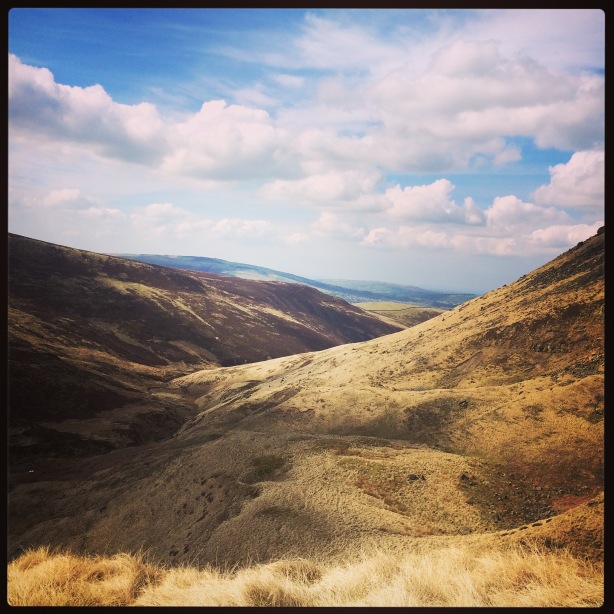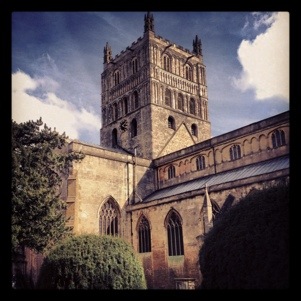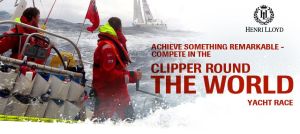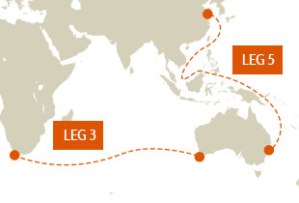Three months ago we relocated from Bristol to a small mill-town on the Northern edge of the Peak District, and lovely it is. From our front door we can walk for ten minutes and be in staggeringly beautiful and dramatic countryside. Being nature lovers and dog owners, my wife and I are relishing the change of scene after twenty five years of urban living. We now wake up to the sound of bird song rather than the unintelligible shouts of the crack addicts on our doorstep or the cheery, expletive-laden banter of the lads from the window workshop next door. And we have been sleeping right through the night for the first time in seven years, no longer jarred from sleep by the cacophonous, drunken burblings of students wending their way home at all hours. It is all quite wonderful.
A few weeks into our new life, we took a walk “up the back” along a path known as Doctor’s Gate, an old Roman baggage trail that leads up through farmland and onto the Dark Peak where, in time, it bisects the Pennine Way and continues down to the Snake Pass. It was midday on Friday February 2nd and it was the first dry, bright day in weeks. We passed Mossy Lea Farm and climbed up the wide track to the barn on the hill, where dry stone walls criss-cross the fields. There were hawks circling, red grouse warbling, sheep bleating. You get the picture. It’s a rural idyll. Following a wooden sign which points the way to “Open Country”, the path leads down and along the serpentine Shelf Brook, which sends water racing down the valley and which once powered the town’s booming mills and factories; mostly gone now or remodelled as flats and retail outlets. After some invigorating walking, negotiating bogs and heather and slippery slopes of stone and peat, we came to a footbridge over the stream. We stopped and admired the scenery. The path continues from there upwards quite steeply onto the next great hill and from thence to the Pennine Way. We agreed that we’d save that for another day and would head back the way we’d come.
As we were gazing up at the path we weren’t going to take, all at once, and entirely without warning, coming straight towards us over the horizon of the hill, directly above us, was an enormous, silver-coloured aeroplane. It was flying directly towards us and was incredibly close to the ground. Like, really, really close. So close that you felt that if you reached out your hand you would almost be able to touch it. So close, that we thought it was going to crash into the hillside in front of us. Almost instantly, as if it had suddenly seen us and been shocked by our presence, the aircraft turned and banked sharply to the left, pulling up and away from the ground and disappeared over the hill to our right. We both stood, open-mouthed, shocked and surprised by what we’d just seen. “What the hell is that doing there?” I exclaimed. It was so out of place. So extraordinary. So unexpected. And the weird thing was that neither of us recalled hearing its approach, or its departure. Had it been silent? And yet, it clearly had two propellers. It wasn’t a modern plane. It looked like something from the 40s or 50s. A smallish passenger plane that might hop you across to Le Touquet for lunch and back in time for a show at the Theatre Royal Haymarket. The kind of plane that Howard Hughes would fly or Ingrid Bergman and Paul Henreid would step out of. It had a row of small windows or portholes above the starboard wing. It had no markings or insignia. It looked like a big, fat, silver cigar. The word Dakota sprang to mind, but only because it was a plane I vaguely knew of thanks to my brother’s nerdy interest in aeroplanes when we were kids. But it was somehow, Other. And it never reappeared. We waited, expecting to see it rise up above the hill and continue on its flight. But it didn’t. It just disappeared.
We turned back along the path and we both agreed that it was odd. And that, if we had been alone, neither of us would have believed what the other said they had seen. We were both shaken a little, as if we had seen something we couldn’t quite explain. We knew it wasn’t a modern plane flying in or out of Manchester Airport. They do so all the time here. We’re used to seeing them in the skies above us but they are distant, far away, and resolutely large, modern aircraft, bearing the insignia of Easy Jet or whatever other airline they belong to. We didn’t talk about it much more on the way home. What could we say? Once we were inside, pink cheeked and furnished with mugs of tea, I decided to investigate. I checked online to see if the RAF makes training flights in the area. After all, like the Lake District, the Peak District offers vast tracts of uninhabited landscape over which to practice low level flying. Yes, the RAF do fly training flights in the area but only Hercules and Atlas aircraft, both much bigger than the plane we had seen, and with four props a piece. And clearly marked with military insignia, unlike our aeroplane. I looked to see if there had been any vintage airshows in the area. Maybe this plane was on its way to one? Nothing. Then I saw a link. Ghost Planes of Derbyshire. No fucking way. I followed it and a whole load of newspaper articles emerged, local and national, reporting sightings over the years of large, silent, “WW2 type” aircraft in the area. I was staggered. I had no idea that we had moved into an area that some were likening to the Bermuda Triangle of the UK. And it transpired that, perhaps not surprisingly, over the years the Peak District has been the scene of many fatal air crashes and, where we had walked, in particular, was the location of three air disasters between 1939 and 1948, two of which resulted in the deaths of the entire crews. The most famous of these was the crash of the USAF RB29 Superfortress, “Overexposed”, on November 3rd 1948, when 13 American aircrew lost their lives as their reconnaissance aircraft ploughed into Bleaklow in bad weather.
What was obvious from the various articles and websites devoted to these unexplained sightings was that, for every believer, there were many skeptics, often brutal in their denial of such things. It was nonsense, of course, or hysteria, or attention-seeking idiots or alien-loving tree-huggers etc etc. Just a fortnight ago, the RAF were compelled to issue a statement reassuring people that the strange aircraft they had seen flying at speed over Derbyshire were, indeed, theirs – three Hercules aircraft, in fact, flying on training missions at low height. I have seen Hercules aircraft, growing up as I did near Salisbury Plain, and both my father and brother have flown in them, and what we saw was not a Hercules. Several local residents have pulled out the “I’ve lived in the area for thirty years and have never seen anything so therefore it’s a load of bollocks” card. Well, I’ve lived in the area for three months and I have seen something, but I don’t exactly know what.
Over the next few weeks I did a little research and read up on the crashes in the area. I took the dog up to the Pennine Way above Doctors Gate to visit the wreckage of the Superfortress, which still lies at the crash site, seventy years on. It has a memorial stone and visitors leave poppies of remembrance for the dead airmen. Strangely, on the day I went looking for the crash site, I couldn’t find it. It’s a little way off the Pennine Way but easy enough to find once you get to a trig point, but I couldn’t find the trig point either. I had an OS map, and I’d read directions from previous visitors but I just couldn’t find it. I knew I was in the right area, and made several attempts to reach the trig point from different angles but then the weather came in, visibility dropped and it remained hidden. We trudged over heather and through peat bogs, stood on stones and recalibrated the angles of approach, but I couldn’t find it and in the end we went home, wet, cold and disappointed. It almost felt like the site didn’t want me to find it. Which, I know, sounds ridiculous.
Two days later, it was a glorious sunny day and Gertie and I set out again, this time from Doctors Gate. We passed over the footbridge with the idea of scrambling up the very steep side of Ashton Clough opposite us to Bleaklow Head, where the trig point is. I had read a report of the second of the three crashes that had happened in the area in 1945 and was particularly interested because, not only did it happen just where we saw our plane, but the aircraft involved was a USAF Douglas Dakota. And again, tragically, the entire crew of seven were killed. Once we were there, the clough looked almost inaccessible and I wasn’t sure that Gertie and I were really up for such an energetic climb. As I was about to turn back, a fell-runner appeared from the bottom of the hill and, whilst he made a fuss of Gertie, we chatted routes for a bit. He said the climb up to the trig point from there wasn’t too bad and that there were styles and paths to follow up the slope and across the moor. And he was gone, up Doctors Gate towards the Pennine Way. So, encouraged and feeling intrepid, we pressed on too, but we went down the hill, across the brook and over a style into the clough, where a stream falls down the steep ravine in waterfalls and boggy pools. The going was tough, whatever that runner had said. It was a near vertical climb of about fifteen minutes over tufty, bumpy grass, sheepshit and rough terrain and both Gertie and I had to stop several times to catch our breath and rest our aching legs. But the reward was spectacular. The peaks opened up before us as we climbed higher and the view went on for miles and miles. It was breathtaking. Literally. I didn’t come across any of the wreckage of the Dakota, even though I have seen pictures of where it lies and we must have been very close. (This was becoming a recurring theme.) Eventually we gained the summit (notwithstanding a mild moment of panic when Gertie disappeared after a startled Mountain Hare) and I clambered up to embrace the elusive trig point, at last. Here it was. I took my phone out to take a photo, as evidence of my success, and it instantly packed in and died. Honestly. You couldn’t make it up. Things round these parts are very shy, it seems. So I set off for the RB29 crash site and there it was. About 100 yards North of the trig, the ground gives way to a gravelly wide path of stones and grit and littered all across it is wreckage, scattered randomly over a huge area. Tiny bits of metal, huge parts of wings, rusting engines and wheel bases, even a large piece of rubber tyre still exists. After seventy years. On a blasted mountain top at 600+ meters above sea level. It is extraordinary. Because it looks as if it has just happened. Or rather, as if an art department has painstakingly recreated the site of an air disaster for a movie. It feels placed. Delicately. As if the weather that must have rained upon it, snowed upon it, howled upon it and blown it from place to place for almost seventy years, has had no effect whatsoever. One large piece of aluminium was so shiny and new looking that I could read the serial number stamped into it as if it had just come off the production line. There was no sign of the inferno that had engulfed the plane and her crew on impact, and which had apparently been so intense that humans and metal alike were melted into strange shapes into the ground. A ragged poppy wreath flapped in the breeze. The atmosphere was quiet. Significant. But sad rather than eerie. It had the feel of a long abandoned base camp at the foot of Everest; a material testament to the aspirations and derring-do of long dead men. I tried once more to get my phone to work. It powered up just long enough for me to take two third rate photographs before it shut down again. I made a silent prayer for the dead Americans and set off for home across the moor.

Looking West from Ashton Clough.
To be continued….I have no doubt…




 s. (Leg 3 on the map)Both names which strike a chilly sliver of fear in me but which also conjure up historic and dramatic achievement in the lives of sailors across the ages. What an achievement that would be indeed, to conquer the roller coaster of massive seas, freezing temperatures and colossal winds. What a terrifying, dreamlike challenge to fight the fear and the frailty of the human mind, body and spirit and race through the dark, stormy nights of the soul and the sea combined! Most of my family think I’m mad, but are being wonderfully supportive and have been instrumental in drumming up votes.
s. (Leg 3 on the map)Both names which strike a chilly sliver of fear in me but which also conjure up historic and dramatic achievement in the lives of sailors across the ages. What an achievement that would be indeed, to conquer the roller coaster of massive seas, freezing temperatures and colossal winds. What a terrifying, dreamlike challenge to fight the fear and the frailty of the human mind, body and spirit and race through the dark, stormy nights of the soul and the sea combined! Most of my family think I’m mad, but are being wonderfully supportive and have been instrumental in drumming up votes.